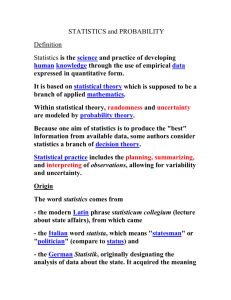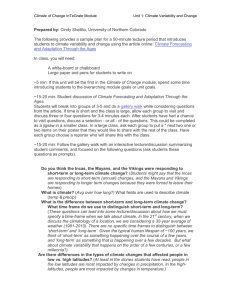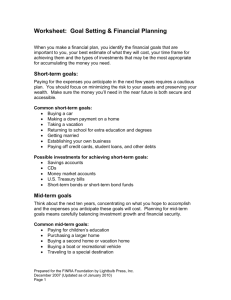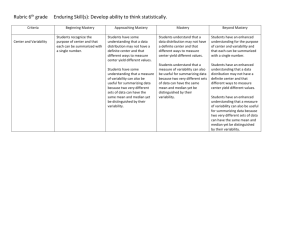quest02
advertisement
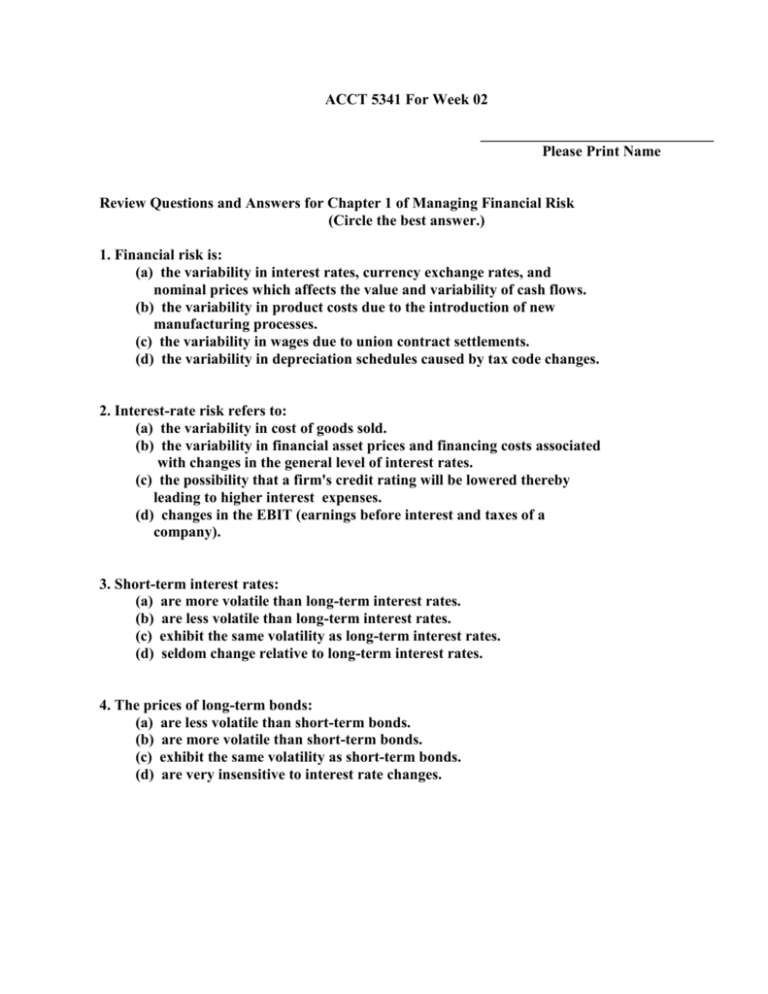
ACCT 5341 For Week 02 _______________________________ Please Print Name Review Questions and Answers for Chapter 1 of Managing Financial Risk (Circle the best answer.) 1. Financial risk is: (a) the variability in interest rates, currency exchange rates, and nominal prices which affects the value and variability of cash flows. (b) the variability in product costs due to the introduction of new manufacturing processes. (c) the variability in wages due to union contract settlements. (d) the variability in depreciation schedules caused by tax code changes. 2. Interest-rate risk refers to: (a) the variability in cost of goods sold. (b) the variability in financial asset prices and financing costs associated with changes in the general level of interest rates. (c) the possibility that a firm's credit rating will be lowered thereby leading to higher interest expenses. (d) changes in the EBIT (earnings before interest and taxes of a company). 3. Short-term interest rates: (a) are more volatile than long-term interest rates. (b) are less volatile than long-term interest rates. (c) exhibit the same volatility as long-term interest rates. (d) seldom change relative to long-term interest rates. 4. The prices of long-term bonds: (a) are less volatile than short-term bonds. (b) are more volatile than short-term bonds. (c) exhibit the same volatility as short-term bonds. (d) are very insensitive to interest rate changes. 5. Duration is: (a) a way of summarizing information about the manufacturing costs of a company. (b) a way of summarizing information about the sensitivity of bond prices to changes in credit rating. (c) a way of summarizing information about the sensitivity of bond prices to changes in the bond's yield to maturity. (d) a way of summarizing information about the sensitivity of product prices to interest rate changes. 6. The term structure of interest rates describes the relationship between the: (a) default risks of bonds and their yields to maturity. (b) current yields of bonds and their yields to maturity. (c) prices of bonds and their yields to maturity. (d) maturities of bonds and their yields to maturity. 7. According to the expectations theory of the yield curve, a downward sloping yield curve means that market participants expect: (a) short-term interest rates to rise. (b) short-term interest rates to stay the same. (c) short-term interest rates to fall. (e) bond prices to fall. 8. The term structure theory which predicts long-term interest rates will, on average, be higher than short-term interest rates is called: (a) the expectations theory. (b) the preferred habitat theory. (c) the segmented market theory. (d) the liquidity preference theory. 9. The goal of financial engineering is to: (a) increase risk so as to increase expected rates of return on corporate investments. (b) earn profits by speculating in financial markets. (c) reduce financial risk and lock in risk-free returns. (d) mislead investors about the financial risks the firm has under taken. 10. A major purpose of financial risk management is to: (a) increase the profitability of the company by taking on high-risk positive net present value investments. (b) increase the market value of the company by lowering its overall cost of capital. (c) reduce the volatility of the reported net profit of a company. (d) take control of the firm away from the shareholders and place it in the hands of the managers. Review Questions S&C Textbook Chapter 10 11. Which of the three following methods of accounting for gain or loss from refunding transactions are required under SFAS No. 4: (a) Amortize the gain or loss over the life of the new debt issue. (b) Amortize the gain or loss over the remaining life of the original issue. (c) Recognize the gain or loss at the time of the refunding transaction. (d) None of the above answers is correct. 12. Which of the three methods above provides a balance sheet measure that reflects the present value of the future cash flows discounted at the interest rate that is commensurate with the risk associated with the new debt issue? Why? 13. Which of the three following methods of accounting for gain or loss from refunding transactions are required under SFAS No. 4: (a) Disclose the gain or loss as an extraordinary item. (b) Disclose the gain or loss as ordinary income unless it is “unusual in nature.” (c) Disclose the gain or loss as ordinary income whether whether or not it is “unusual in nature.” (d) Disclose the gain or loss as comprehensive income. 14. Which of the three following methods of accounting for loss from a debt restructuring transaction that partly reduces the amount owed by a troubled former customer? (a slightly different type of early extinguishment) (a) Amortize the loss over the life of the revised debt payoff term. (b) Amortize the loss over the remaining life of the original issue. (c) Recognize the loss at the time of the restructuring agreement. (d) None of the above answers is correct. 15. Which of the three methods above provides a balance sheet measure that reflects the present value of the future cash flows discounted at the interest rate that is commensurate with the risk associated with the new restructuring? How should the interest rate be revised in a debt restructuring? Review Questions of Derivative Financial Instruments 16. What are the main differences between call options versus forward contracts? 17 What are the main differences between forward versus futures contracts?

